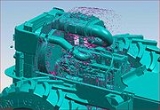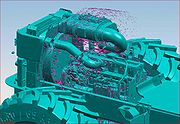
Collaborative Product Development
Encyclopedia
Collaborative product development (collaborative product design) (CPD) is a business strategy, work process and collection of software applications that facilitates different organizations to work together on the development of a product. It is also known as collaborative product definition management (cPDM).
areas of: Product Data Management
(PDM); Product visualization; team collaboration and conferencing tools; and supplier sourcing software. It is generally accepted as not including CAD geometry tools, but does include data translation
technology.
such as email and chat (instant messaging) is used within the CPD process. One important technology is application and desktop sharing, allowing one person to view what another person is doing on a remote machine. For CAD
and product visualization applications an ‘appshare’ product that supports OpenGL
graphics is required. Another common application is Data sharing via Web based portals.
data an important addition is the handling of high volumes of geometry and metadata. Exactly what techniques and technology is required depends on the level of collaboration being carried out and the commonality (or lack of) the partner sites’ systems.
Appropriate technologies are required to support collaboration across these boundaries.
People
Effective PLM collaboration will typically require the participation of people who do not have high level CAD skills. This requires improved user interfaces including tailorable user interfaces that can be tailored to the skill level and specialty of the user.
 Improved visualization capabilities, especially those that provide a meaningful view of complex information such as the results of a fluid flow analysis will leverage the value of all participants in the collaboration process.
Improved visualization capabilities, especially those that provide a meaningful view of complex information such as the results of a fluid flow analysis will leverage the value of all participants in the collaboration process.
Effective collaboration requires that a participant be freed from the burden of knowing the intent history typically imbedded within and constricting the use of parametric models.
Organizations
Community collaboration requires that companies, suppliers, and customers share information in a secure environment, ensure compliance with enterprise and regulatory rules and enforce the process management rules of the community as well as the individual organizations.
Data
The most basic collaboration data need is the ability to operate in a MultiCAD environment. That is, however, only the beginning. Models from multiple CAD sources must be assembled into an active digital mockup allowing change and/or design in context.
With different CAD systems the approach varies slightly depending on whether the ownership, and therefore authorship of components changes or not. If geometry only has to be viewed then a Product visualization neutral file format (e.g.JT
) can be used for tasks such as viewing, markup (redlining) or multi-cad digital mock-up (DMU). It maybe that authorship does not change but components from one group needs to be placed in the assembly of another group so that they can construct their parts, so called work in context. This requires transfer of geometry from one format to another by means of a visualization format or full data translation. Between some systems there is the possibility of ‘data interoperability’ were geometry from one format can be associatively copied to another. If the ownership of a particular file is being transfer then full data translation is required using some form of CAD data exchange
technology. For the translation process Product Data Quality (PDQ) checkers are often employed to reduce problems in transferring the work.
If different PDM/EDM systems are in use then either data structures or metadata can be transferred using STEP
or communication between databases can be achieved with tools based around XML
data transfer.
Introduction
Exactly what technology comes under this title does vary depending on who you ask; however, it usually consists of the PLMProduct lifecycle management
In industry, product lifecycle management is the process of managing the entire lifecycle of a product from its conception, through design and manufacture, to service and disposal...
areas of: Product Data Management
Product Data Management
Product data management is the business function often within product lifecycle management that is responsible for the creation, management and publication of product data...
(PDM); Product visualization; team collaboration and conferencing tools; and supplier sourcing software. It is generally accepted as not including CAD geometry tools, but does include data translation
CAD data exchange
CAD data exchange involves a number of software technologies and methods to translate data from one Computer-aided design system to another CAD file format...
technology.
Technologies and methods used
Clearly general collaborative softwareCollaborative software
Collaborative software is computer software designed to help people involved in a common task achieve goals...
such as email and chat (instant messaging) is used within the CPD process. One important technology is application and desktop sharing, allowing one person to view what another person is doing on a remote machine. For CAD
Computer-aided design
Computer-aided design , also known as computer-aided design and drafting , is the use of computer technology for the process of design and design-documentation. Computer Aided Drafting describes the process of drafting with a computer...
and product visualization applications an ‘appshare’ product that supports OpenGL
OpenGL
OpenGL is a standard specification defining a cross-language, cross-platform API for writing applications that produce 2D and 3D computer graphics. The interface consists of over 250 different function calls which can be used to draw complex three-dimensional scenes from simple primitives. OpenGL...
graphics is required. Another common application is Data sharing via Web based portals.
Specific to product data
With productProduct (business)
In general, the product is defined as a "thing produced by labor or effort" or the "result of an act or a process", and stems from the verb produce, from the Latin prōdūce ' lead or bring forth'. Since 1575, the word "product" has referred to anything produced...
data an important addition is the handling of high volumes of geometry and metadata. Exactly what techniques and technology is required depends on the level of collaboration being carried out and the commonality (or lack of) the partner sites’ systems.
Specific to PLM and CAx collaboration
Collaboration using PLM and CAx tools requires technology to support the needs of:- People. Personnel of different disciplines and skill levels;
- Organizations: Organizations throughout an enterprise or extended enterprise with different rules, processes and objectives;
- Data: Data from different sources in different formats.
Appropriate technologies are required to support collaboration across these boundaries.
People
Effective PLM collaboration will typically require the participation of people who do not have high level CAD skills. This requires improved user interfaces including tailorable user interfaces that can be tailored to the skill level and specialty of the user.

Effective collaboration requires that a participant be freed from the burden of knowing the intent history typically imbedded within and constricting the use of parametric models.
Organizations
Community collaboration requires that companies, suppliers, and customers share information in a secure environment, ensure compliance with enterprise and regulatory rules and enforce the process management rules of the community as well as the individual organizations.
Data
The most basic collaboration data need is the ability to operate in a MultiCAD environment. That is, however, only the beginning. Models from multiple CAD sources must be assembled into an active digital mockup allowing change and/or design in context.
Real-time collaborative product design
Product design is typically a highly iterative and interactive activity involving a group of designers who are geographically dispersed. A neutral modeling commands (NMC) based method is proposed to construct a real-time collaborative product design platform within heterogeneous CAD systems . Different from the visualization-based approaches, models can be constructed and modified synchronously from various sites in the proposed collaborative design environment. Based on a translation mechanism between system modeling operations (SMO) and neutral modeling commands (NMC), every operation given by a user on one site will be translated into a NMC and be sent to all the other sites through the network. When the other sites receive this command, it is converted into corresponding SMOs on the local system. In this way, the real-time collaborative product design with heterogeneous CAD systems is achieved.Different levels of collaboration
If the collaborating parties have the same PDM and CAD systems the task usually involves the direct access and transfer of data between sites. The PDM system will have data storage at more than one site for the large graphics files, file may be copied between sites, how they are synchronized being controlled by the server(s). For the management server and metadata there are a number of options. There could be a single server that is accessed from all locations or multiple PDM servers that communicate with one another. In both cases the PDM software controls access for groups defining what data they can see and edit.With different CAD systems the approach varies slightly depending on whether the ownership, and therefore authorship of components changes or not. If geometry only has to be viewed then a Product visualization neutral file format (e.g.JT
JT (visualization format)
JT is a 3D data format developed by and is used for product visualization, collaboration, and CAD data exchange. It can contain any combination of approximate data, exact boundary representation surfaces , Product and Manufacturing Information , and Metadata either exported from the native CAD...
) can be used for tasks such as viewing, markup (redlining) or multi-cad digital mock-up (DMU). It maybe that authorship does not change but components from one group needs to be placed in the assembly of another group so that they can construct their parts, so called work in context. This requires transfer of geometry from one format to another by means of a visualization format or full data translation. Between some systems there is the possibility of ‘data interoperability’ were geometry from one format can be associatively copied to another. If the ownership of a particular file is being transfer then full data translation is required using some form of CAD data exchange
CAD data exchange
CAD data exchange involves a number of software technologies and methods to translate data from one Computer-aided design system to another CAD file format...
technology. For the translation process Product Data Quality (PDQ) checkers are often employed to reduce problems in transferring the work.
If different PDM/EDM systems are in use then either data structures or metadata can be transferred using STEP
ISO 10303
ISO 10303 is an ISO standard for the computer-interpretable representation and exchange of product manufacturing information. Its official title is: Automation systems and integration — Product data representation and exchange...
or communication between databases can be achieved with tools based around XML
XML
Extensible Markup Language is a set of rules for encoding documents in machine-readable form. It is defined in the XML 1.0 Specification produced by the W3C, and several other related specifications, all gratis open standards....
data transfer.
External links
- MetaCollab.net - Collaboration & business - a free collaborative encyclopedia on collaboration.

